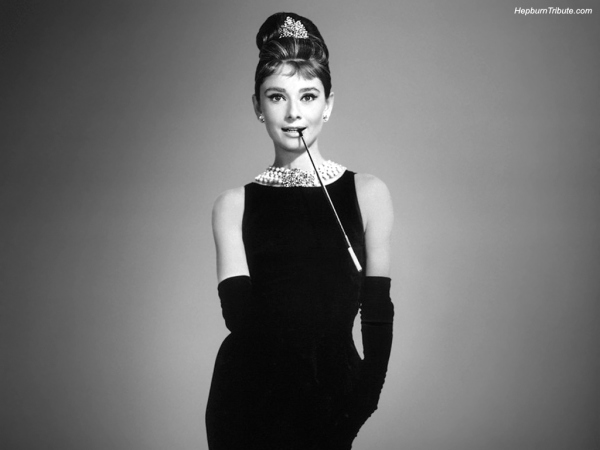The 1950s was a vital time to solidify the connection between fashion and cinema and make them “mutually supporting channels of exploitation”. Designers became increasingly important for Hollywood and stars. The "little black dress", created by Coco Chanel, was immortalized in Audrey Hepburn's body. The mixture of her youthful air with the classic haute couture clothes symbolizes the transformation that began to occur in that period. It also solidifies the relationship between cinema and fashion as catalysts for each other’s success. Hepburn was synonymous with class and beauty for many generations. Her importance for the fashion industry can be seen through the survival of her image as an icon even after her death, in commercials (such as the Galaxy chocolate commercial below).
 |
| Audrey Hepburn in Breakfast at Tiffany's (1961) |
Compared to the divas that preceded her, such as Rita Hayworth and Marilyn Monroe, that had lush bodies and seductive looks, Audrey meant a break for this pattern of beauty. Audrey not only presented a different look but also an ambiguous one that had never been portrayed in film before. At the same time that she had a fragile, delicate and feminine air, she was also the maturation of masculine features that undermined feminity itself. By challenging the typical mammary woman look, she represented hope, inspiration and freedom for many women of the time. This put her in another level than the other stars because it pushed forward an idea of an independent woman that refused to be molded by the studio. She represented the feminine space but with certain masculine aspects that gave her an individualistic appeal.
 |
| Marilyn Monroe and Audrey Hepburn |
Her unidentifiable origin, which many times made her seem American, European, neither and both – all at the same time, is also what allows her to arrive as an event. She represented a type of ambiguous nationality that fit an important time in the American economy; the consumerist boom. She propagated the rise of transatlantic tourism and represented the europization of Hollywood. This period was a vital time to calcify the cinema’s role in promoting tourism.
The most interesting thing is that Audrey’s star persona and actual persona are very difficult to separate for many fans, including myself. Her off-screen independent personality many times matches the characters that she played in her movies. As Brown pointed out her”faults as a real person and limitations as an actress” are what gives her status as an event. In the movie, Roman Holiday (1953), Audrey Hepburn plays a princess, Ann, who flees in search of adventure and a different life from the predictable boring one that she lived. Hepburn appears with short hair, demonstrating a radical change in the feminine ideal of the 50s to the “modern” independent woman of the 60s. Unlike the majority of today's actresses who shed rivers of tears to show sadness, give hot kisses to demonstrate passion, or big smiles to show joy, Audrey needed a lot less to convey the same feelings, just a look.

No comments:
Post a Comment
Note: Only a member of this blog may post a comment.